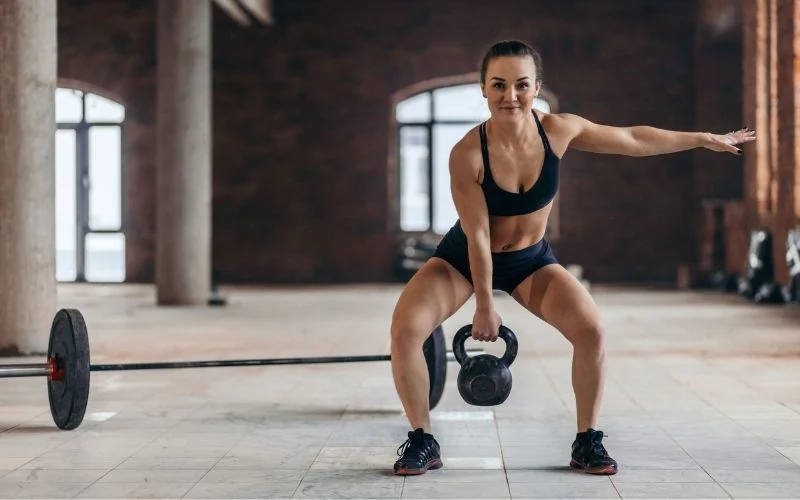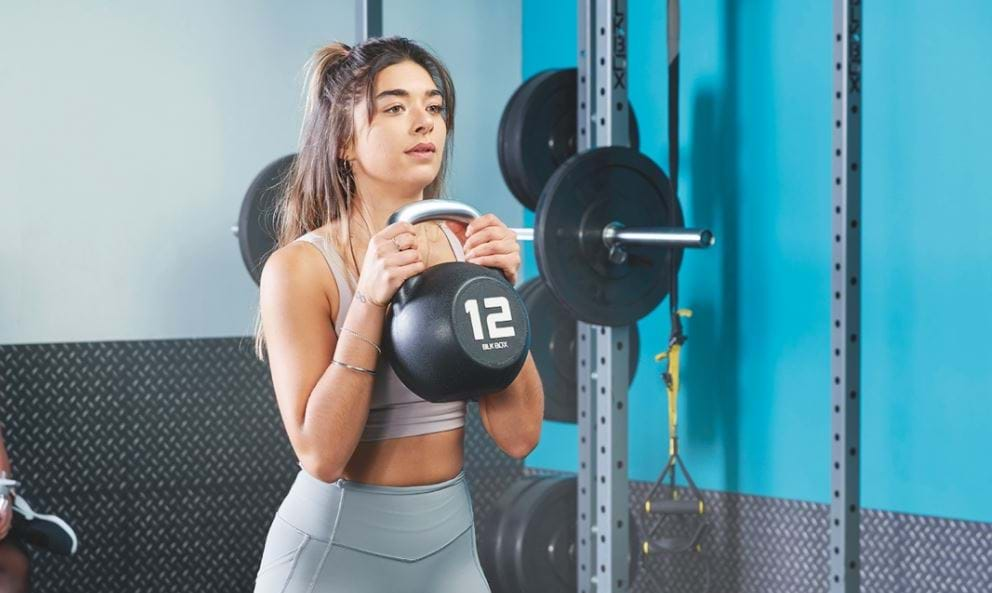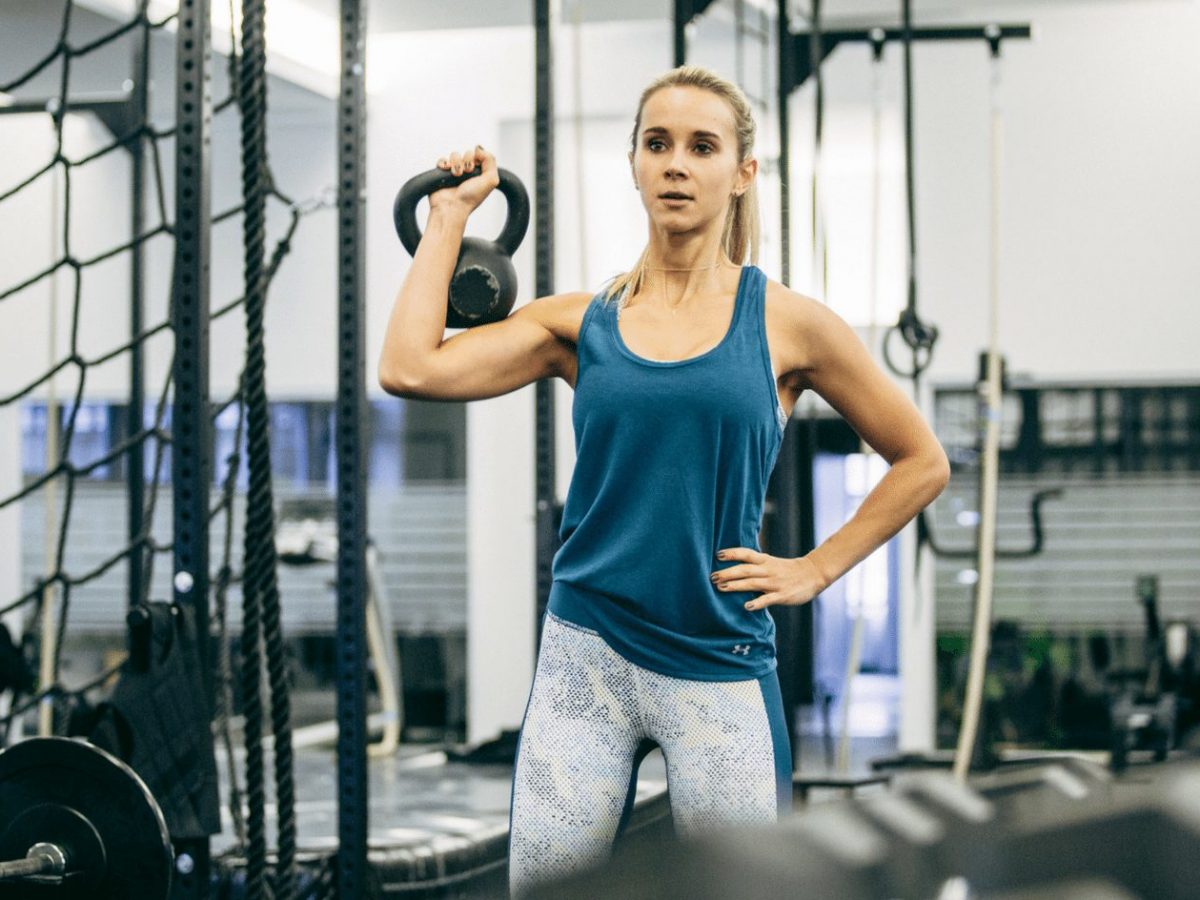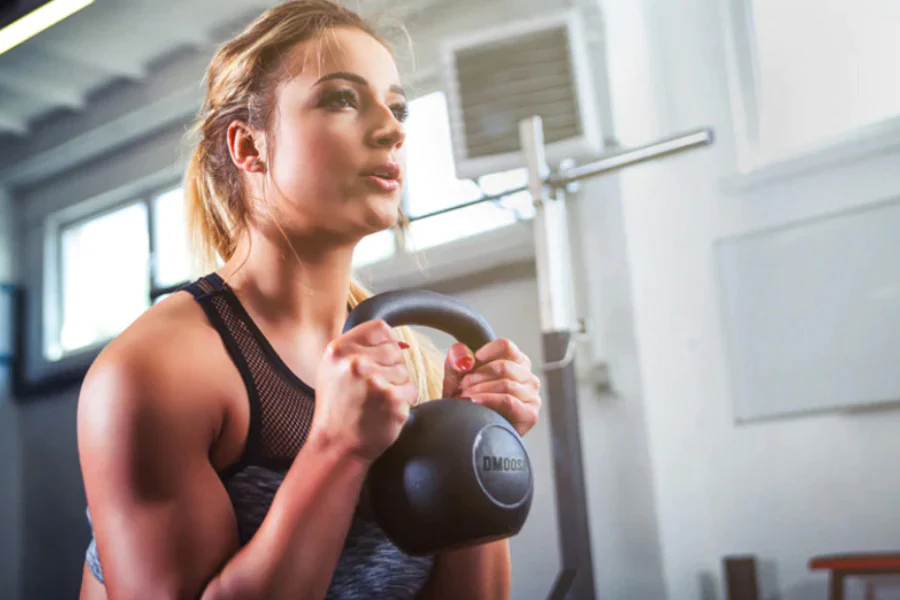Choosing the right kettlebell weight is crucial for effective training, especially for women who are new to kettlebell exercises. The ideal weight depends on fitness level, experience, and the type of workout. Today we will find out how women can select the best kettlebell weight to enhance their strength safely and effectively, ensuring progress in their fitness journey without the risk of injury.

Contents
- 1 What Weight Kettlebell Should A Woman Use?
- 2 Benefits of Kettlebell Workouts for Women
- 2.1 1. Full-body Conditioning
- 2.2 2. Enhanced Core Strength and Stability:
- 2.3 3. Increased Power and Explosiveness:
- 2.4 4. Improved Balance and Coordination:
- 2.5 5. Flexibility and Range of Motion:
- 2.6 6. Cardiovascular Fitness:
- 2.7 7. Weight Loss and Increased Metabolism:
- 2.8 8. Convenience and Versatility:
- 2.9 9. Mental Toughness:
- 2.10 10. Social and Fun:
- 3 Frequently Asked Questions
What Weight Kettlebell Should A Woman Use?
Choosing the right kettlebell weight is essential for women to ensure that they effectively meet their fitness goals while minimizing the risk of injury. The appropriate kettlebell weight varies depending on several factors, including strength level, fitness experience, and the specific exercises planned. Here’s a guide to help women determine the most suitable kettlebell weight:
1. Beginner:
If you are new to weightlifting or kettlebell exercises, it’s important to start with a weight that allows you to focus on learning proper form and technique without straining your muscles. Typically, a good starting weight for women who are beginners is:
- 8 kg (about 18 lbs) for general exercises.
- 4 kg to 6 kg (9–13 lbs) for movements that require more precision and arm work, such as kettlebell swings, rows, or presses.
2. Intermediate:
Women who have some experience with kettlebells and have developed good form and strength can opt for a heavier weight. This level involves moving up from the beginner weights as you gain confidence and strength. Suitable weights for intermediate users are:
- 12 kg (about 26 lbs) for standard exercises like swings and squats.
- 8 kg to 10 kg (18–22 lbs) for more technical moves that require greater control.
3. Advanced:
For women who are comfortable with kettlebells and have a strong base in weight training, advanced weights can be used to further enhance strength and conditioning. Advanced users often work with:
- 16 kg (about 35 lbs) or more for powerful exercises like swings, deadlifts, and squats where a heavier weight is manageable.
- 12 kg to 16 kg (26–35 lbs) for overhead presses, snatches, and other dynamic movements.

General Guidelines
- Choose a weight that challenges you but doesn’t compromise your form. If you notice that your technique is suffering or you can’t complete the desired number of repetitions, consider reducing the weight.
- Consider the type of exercises. Movements that involve larger muscle groups or two-handed exercises can typically handle heavier weights, whereas exercises that use smaller muscle groups or are single-arm should use lighter weights.
- Test different weights. If possible, try different weights to find what feels best for your current level and goals. Most gyms have a range of kettlebells you can test.
Benefits of Kettlebell Workouts for Women
Kettlebell workouts offer a unique blend of strength training, cardiovascular fitness, and flexibility that can be particularly beneficial for women. These versatile pieces of equipment provide a dynamic, efficient workout that can help with everything from muscle toning to improving overall fitness. Here are some of the key benefits of kettlebell workouts for women:

1. Full-body Conditioning
Kettlebells provide a comprehensive workout that targets multiple muscle groups across the body. Exercises like kettlebell swings, snatches, and turkish get-ups engage everything from your core to your shoulders, legs, and back. This full-body engagement helps improve muscular endurance and strength.
2. Enhanced Core Strength and Stability:
Many kettlebell movements require core activation to stabilize the body during the exercise. Regular kettlebell training strengthens the core muscles, which are vital for good posture, balance, and overall strength. A strong core also reduces the risk of injuries and can improve the overall function in daily activities.
3. Increased Power and Explosiveness:
Kettlebell exercises often involve dynamic movements that require power and speed. Training with kettlebells can increase your explosiveness, which is beneficial not just for athletic performances but also for daily tasks that require a burst of strength, like lifting heavy objects.
4. Improved Balance and Coordination:
The nature of kettlebell training, which often involves swinging movements and weight shifting, helps improve balance and coordination. Mastering these movements can have a positive impact on your body’s ability to coordinate its movements efficiently, enhancing motor skills.
5. Flexibility and Range of Motion:
Kettlebell workouts naturally include movements that stretch your muscles and improve your range of motion. This can lead to better flexibility, reducing the risk of injuries and improving overall fitness performance.
6. Cardiovascular Fitness:
Because kettlebell workouts can be performed in a circuit with minimal rest and involve large muscle groups, they are excellent for cardiovascular training. They help to increase heart rate and improve oxygen consumption, which can lead to better heart health and stamina.
7. Weight Loss and Increased Metabolism:
Kettlebell exercises are great for burning calories and can be a very effective part of a weight loss program. The combination of strength training and cardiovascular effort increases the metabolic rate, not only during the workout but also after you have finished exercising, a phenomenon known as the “afterburn effect.”

8. Convenience and Versatility:
Kettlebells are small and portable, making them perfect for use at home, in the gym, or even while traveling. They are incredibly versatile and can be used for a wide range of exercises, reducing the need for other equipment.
9. Mental Toughness:
The challenge of kettlebell workouts can also help build mental toughness and resilience. The focus and determination needed to perform these exercises correctly can boost confidence and perseverance.
10. Social and Fun:
Kettlebell training can be a fun and social way to exercise. Many gyms offer group kettlebell classes, which provide an opportunity to meet new people and build a community while staying healthy.
Frequently Asked Questions
How effective are 20-minute kettlebell workouts for weight loss?
Yes, they can be effective for weight loss. A 20-minute kettlebell workout involving swings and lifts can burn approximately 20 calories per minute, which totals to around 400 calories.
Can kettlebell workouts help reduce my waist size?
Absolutely! With targeted kettlebell workouts, it’s possible to effectively reduce love handles and achieve a more defined, smaller waistline.
Does the weight of the kettlebell matter?
Yes, it does. It is generally recommended to select a kettlebell weight that is 5 to 15 pounds lighter than what you would typically use for a dumbbell. Using an excessively heavy or light kettlebell can compromise your technique and increase your risk of injury.
What should be the weight of the kettlebell for swings?
Kettlebell swings utilize the strong muscles of the hips, butt, and legs. Therefore, it’s suggested that most men start with a 16kg (35lbs) and women with a 12kg (25lbs) kettlebell for the two-handed swing. These weights can be increased with regular practice.
Is it necessary to have two identical kettlebells?
No, unlike dumbbells, you only need one kettlebell of each size for kettlebell workouts. The unique nature of kettlebell exercises allows for productive workouts with just one tool of each size.

Santhan, known to many as Linda, combines her personal training expertise with exceptional motivational coaching skills. Her articles are not just informative but also incredibly inspiring, encouraging readers to take action and pursue their fitness goals. Linda’s unique approach to writing integrates practical fitness guidance with motivational elements, making her content both useful and uplifting.
